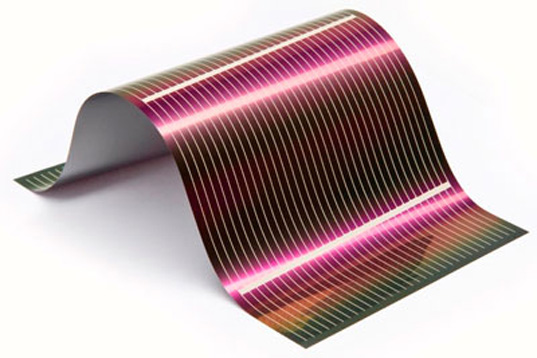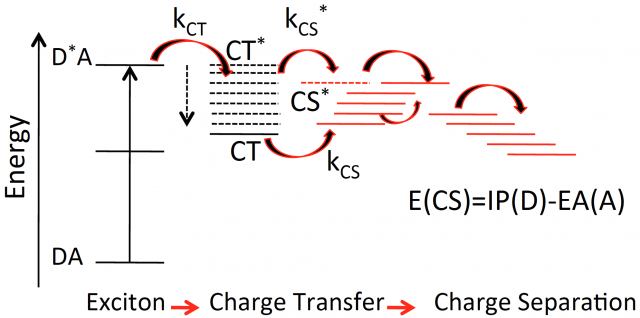Looking for new materials with applications in organic solar cells
Author: María A. Izquierdo-Morelos is a Ph.D. student (ITN-EJD-TCCM) at University of Groningen

Over the past several decades researchers have thought how materials and device architectures can efficiently convert solar radiation into electrical power through the photovoltaic effect. Those efforts have led to different methods and processes to produce green energy. In this context, organic photovoltaic (OPV) technology has received considerable attention because it indeed constitutes a new strategy for creating inexpensive solar cells that can be flexible and lightweight.
Conventional OPVs are made from an absorber or electron donating (D) material in conjunction with an electron accepting (A) material. Upon light absorption by the D material, an electron-hole pair, also known as exciton, is formed. Then excitons either relax to the ground state or migrate to the interface between the D/A heterojunction through exciton transfer processes. At the interface, free charge carriers (electrons and holes) are created and then collected (see Figure 1).

Unlike most inorganic solar cells, where the exciton binding energy is negligible at room temperature, in OPVs the energy required to dissociate the excitons into charge carriers is substantial/significant. Consequently, the efficiency of OPVs is much lower than that of traditional silicon cells.
Nevertheless, the fact that OPVs can be mounted on lightweight, flexible, and easy-to-replace sheets, (which can be spread on roofs and buildings like wallpaper), makes this research field very attractive. Indeed, nowadays more and more people in academy and industry are looking for new mechanisms to design organic solar cells.
To overcome the low efficiency of OPVs all the electronic and optical processes abovementioned have to be well understood from the theoretical and experimental standpoints, and even more challenging, they have to be controlled.
Besides the photoexcitation processes, the nature of the donor and acceptor materials used in the OPV blends has to be addressed. Currently, most of the research is focused on designing new materials that favor exciton diffusion and carrier mobility. Materials with high dielectric constant and permanent interfacial dipoles are potential candidates, since they screen better the charges and therefore decrease the losses by relaxation or recombination of electrons and holes. In this field, the combination of a semiconducting polymer, for example poly-(phenylenevinylene) (PPV) or polythiophenes, and Buckminsterfullerene (C60) derivatives as organic blends is widely used. The advantage of these materials over the flat-junction organic solar cells is a major interpenetration of the two materials that efficiently conduct positive and negative carriers.
Given the difficulty of experimental probes of the electronic and optical processes occurring at the D/A interface, computational/theoretical studies have gained popularity. Computational methodologies, such as those based on the Density Functional Theory (DFT) and its Time Dependent extension (TDDFT), have provided substantial insights in the charge separation processes. Hence both experiments and computational simulations cooperate in the development of more efficient solar cell devices.
From the computational viewpoint, one of the biggest challenges is the modeling of the OPV operation, where environment effects play an important role. In this regard, as preliminary research we have studied excited state properties of D and A complexes embedded in OPV blends by using a polarizable quantum mechanics/molecular mechanics (QM/MM) method, namely the Discrete Reaction Field (DRF) model 1, with TDDFT. To this purpose we work in close collaboration with experimental groups from the University of Groningen, Prof. José Sánchez and the theoretical group Quantum Chemistry of the Excited State of the University of Valencia (QCEXVAL), and with the Software for Chemistry & Materials (SCM) company (an Amsterdam-based computational chemistry software company), from which we use the Amsterdam Density Functional (ADF) modeling suite 2.
In our research, we compute excited state energies in all the steps of the OPV operation. It includes optical spectra of donor and acceptor molecules (PEO-PPV polymer and PTEG-1, respectively 3), charge transfer (CT) energies from donor to acceptor molecules, and charge separated (CS) energies. The last one is computed as a difference between the ionization potential and electron affinity of the blend.
So far, we have seen that the local absorption on the donor molecule and consequent CT and CS energies are strongly dependent of the relative positions of the donor and acceptor. Furthermore, we have found that the environment effects, properly incorporated though the DRF model, relax the CS states, which might indicate that our OPV blends are a good choice to be used in the power generation.
There are still many open questions, however, our work constitutes a base for quantifying and understanding the electronic processes in materials with applications in OPVs.
References
- P. Th. van Duijnen, M. Swart, L. Jensen, “The discrete reaction field approach for calculating solvent effects”, in Solvation Effects on Molecules and Biomolecules (Springer, 2008). ↩
- ADF 2016, SCM, Theoretical Chemistry, Vrije Universiteit, Amsterdam, The Netherlands (www.scm.com). ↩
- S. Torabi, F. Jahani, I. Van Severen, C. Kanimozhi, S. Patil, R. W. A. Havenith, R. C. Chiechi, L. Lutsen, D. J. M. Vanderzande, T. J. Cleij, J. C. Hummelen, L. J. A. Koster. “Strategy for enhancing the dielectric constant of organic semiconductors without sacrificing charge carrier mobility and solubility” Adv. Funct. Mater., 25, (2015), 150. ↩
1 comment
[…] La revolución de las energías renovables pasa necesariamente por la creación de nuevos materiales. Como los materiales orgánicos fotovoltaicos que permitirán la fabricación de células que serán flexibles y, lo que es más importante casi, baratas. María A. Izquierdo-Morelos […]